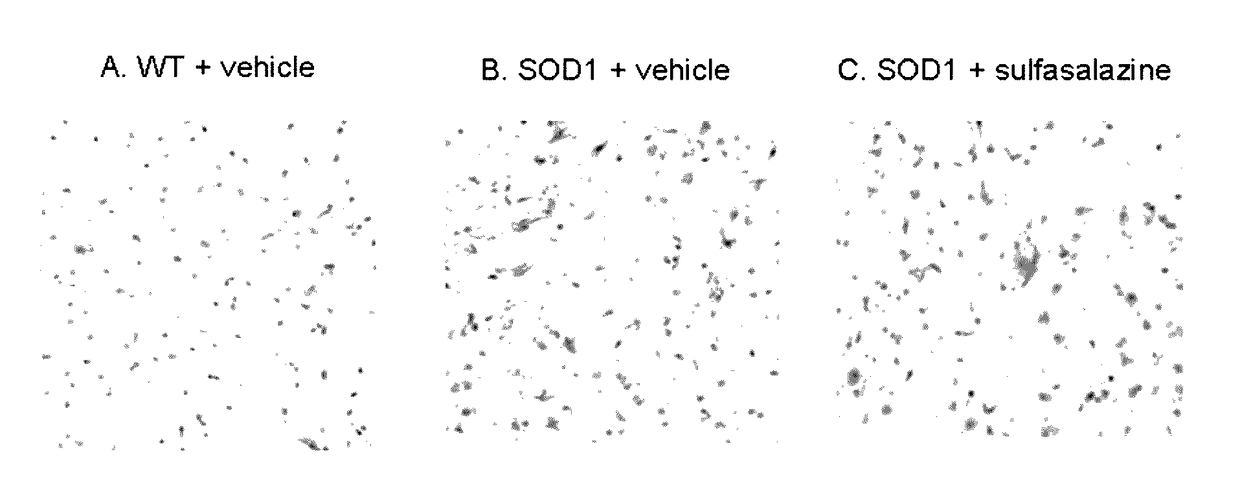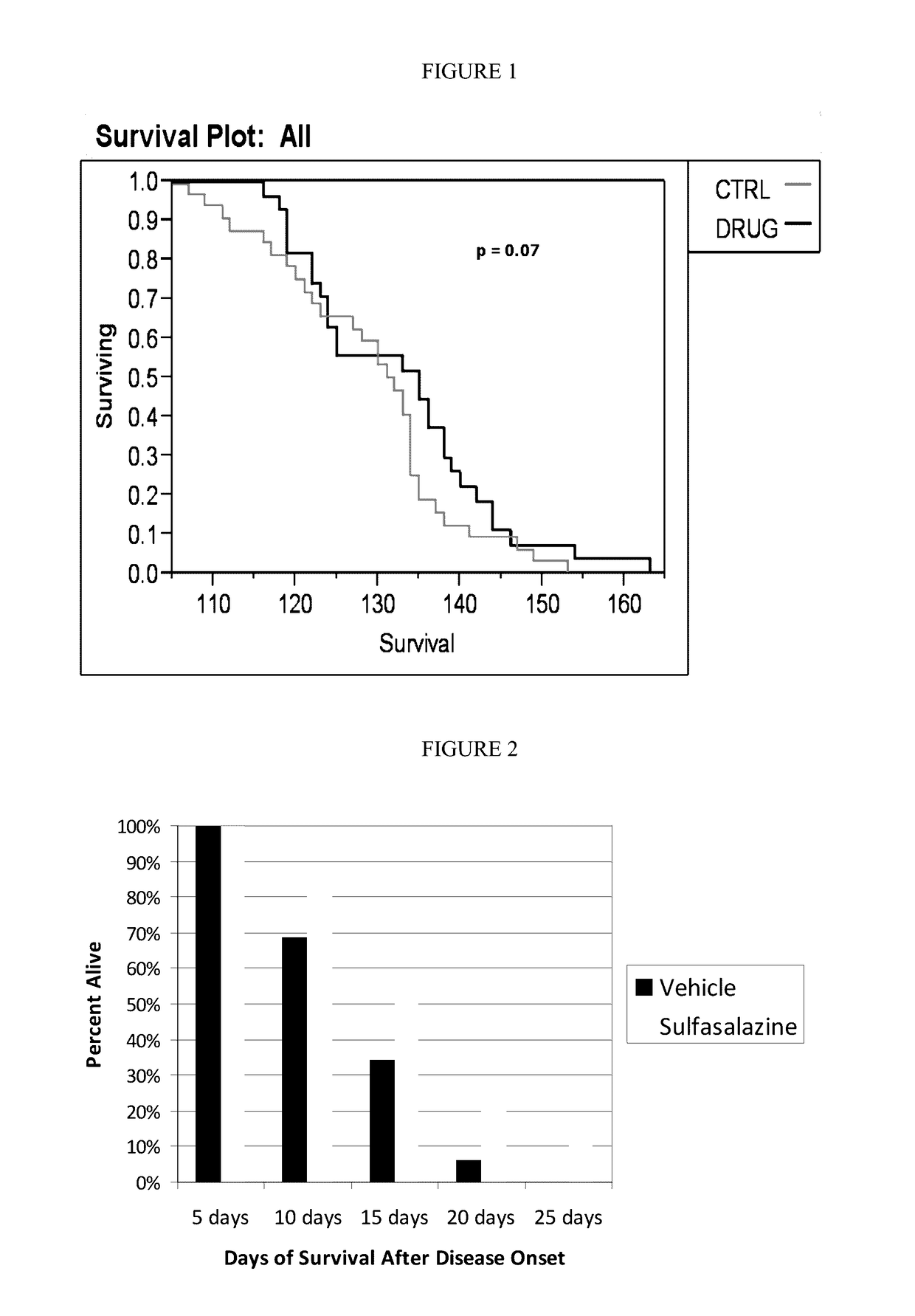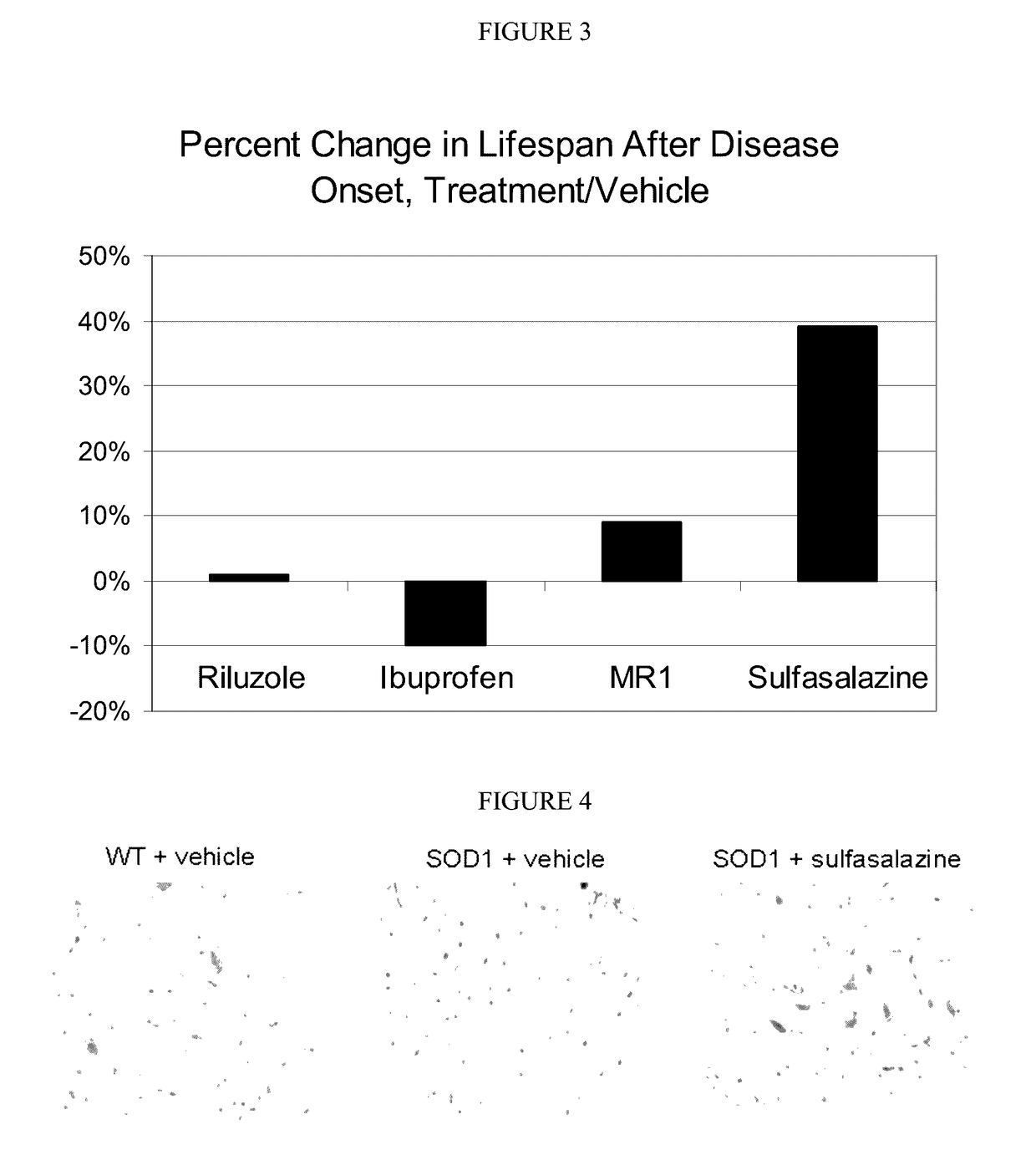Compositions and methods for the treatment of neurodegenerative and other diseases
a neurodegenerative and other disease technology, applied in the field of compositions and methods for the treatment of neurodegenerative and other diseases, can solve the problems of the feedback loop that damages and ultimately kills axons and neurons, including motor neurons, and achieve the effect of reducing damage to axons and neurons
- Summary
- Abstract
- Description
- Claims
- Application Information
AI Technical Summary
Benefits of technology
Problems solved by technology
Method used
Image
Examples
example 1
[0137]Treatment with Sulfasalazine Increases Absolute Survival and Increases the Lifespan of SOD1 Mice after Onset of Definitive Neurological Disease
[0138]The following experiments demonstrate that treatment with sulfasalazine: (1) increased the absolute lifespan of SOD1 mice, and (2) extended lifespan of SOD1 mice after onset of definitive neurological disease. This latter survival parameter is relevant to human patients, who typically will not begin therapy until after definitive diagnosis of ALS.
[0139]High-copy SOD1G93A transgenic mice were derived from the B6SJL-TgN(SOD1G93A)1Gur strain, obtained from The Jackson Laboratory (Bar Harbor, Me.) and originally produced by Gurney, e.g. Gurney et al., Science 264: 1772-1775 (1994). Animal experiments with the SOD1 model were performed at ALS Therapy Development Institute (herein “ALS-TDI”; Cambridge, Mass.). All mice were genotyped to verify copy number of the SOD1 transgene. Animal handling and study protocols were as previously desc...
example 2
Expression of xCT (SLC7A11) is Elevated in the Spinal Cord of SOD1 Mice
[0154]The following studies used quantitative immunohistochemistry to determine: (1) if the expression of xCT in the spinal cord was elevated in SOD1 mice, (2) if so, whether xCT over-expression increased with disease progression, and (3) whether treatment with sulfasalazine affected xCT expression in the spinal cord of SOD1 mice.
[0155]Two ages of mice were chosen for this analysis: day 85, when SOD1 mice show no overt sign of the ALS-like symptomology, and day 100, when SOD1 mice typically begin displaying the first signs of ALS-like symptomology, such as partial collapse of leg extension towards lateral midline (weakness) or trembling of hind legs during a tail suspension test. For the immunohistochemical studies, a total of 48 mice were divided into 6 cohorts of 8 mice each (4 females and 4 males) as shown in Table 5.
TABLE 5Cohorts used in the Immunohistochemical StudiesCohortAge of mouse(n = 8)GenotypeTreatme...
example 3
Sulfasalazine Reduces Levels of Neuroinflammatory Cells in the Spinal Cord of SOD1 Mice
[0163]The following experiments employed quantitative immunohistochemistry to: (1) compare the neuroinflammatory cell populations in the spinal cord of SOD1 mice to the cell populations in wild-type mice, and (2) test whether the treatment with sulfasalazine decreases neuroinflammatory cell populations in the spinal cord of SOD1 mice.
[0164]The same test mice, spinal cord preparations and methods of analysis used in the neuroinflammatory study were identical to those used in the xCT quantitation study. Two neuroinflammatory cell populations were quantitated: (1) activated microglial cells using an antibody to the F4 / 80 antigen, and (2) activated astrocytes, using an antibody to the GFAP antigen. For each objective image, light parameters were optimized and kept consistent across all sections. Images that were captured at 20× were then imported into ImageJ freeware (NIH, Bethesda, Md.). A maximum en...
PUM
 Login to View More
Login to View More Abstract
Description
Claims
Application Information
 Login to View More
Login to View More - R&D
- Intellectual Property
- Life Sciences
- Materials
- Tech Scout
- Unparalleled Data Quality
- Higher Quality Content
- 60% Fewer Hallucinations
Browse by: Latest US Patents, China's latest patents, Technical Efficacy Thesaurus, Application Domain, Technology Topic, Popular Technical Reports.
© 2025 PatSnap. All rights reserved.Legal|Privacy policy|Modern Slavery Act Transparency Statement|Sitemap|About US| Contact US: help@patsnap.com



